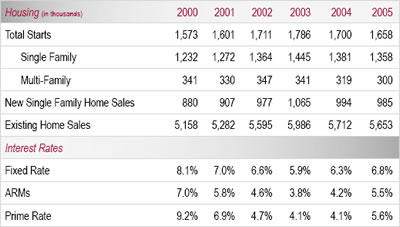Housing
Director, Center for Real Estate Studies, and Charles H. and Barbara F. Dunn Professor of Finance and Real Estate, Kelley School of Business, Indiana University, Bloomington
The jobless recovery has not deterred people from buying homes over the past year and this is expected to continue in 2004. Low interest rates resulted in housing affordability hitting a thirty-year high early in 2003, although rising home prices reduced affordability slightly as the year progressed. Home prices increased about 10 percent for the nation over the past twelve months, pushing the median home price to over $177,000.
The high levels of housing affordability due to low interest rates allowed people to qualify for home mortgages that would not have otherwise qualified, increasing the current homeownership rate to about 68 percent. Many existing homeowners also took advantage of the lower interest rates to purchase larger homes. The average home size has increased steadily in recent years, perhaps partly due to the feeling that one’s home is an investment that may be less risky than the stock market.
Will housing remain strong in 2004? We believe that housing starts will continue near the same level of about 1.7 million to 1.8 million starts (single and multi-family). While a rise in interest rates will dampen housing starts, the continued economic recovery should offset this. And assuming the stock market continues to rise, consumers will feel wealthier and thus more willing to purchase a first home or buy a larger home. Younger people who have been renting or “doubling up” with their parents will be more inclined to purchase a home as the economy improves, and any increase in job growth will be positive for home sales. Table 1 summarizes the housing and interest rate forecast from the National Association of Homebuilders (www.nahb.org).
Table 1
Housing and Interest Rate Forecast

Source: National Association of Homebuilders
The increasing rate of homeownership has taken somewhat of a toll on multi-family housing. The result is declining rental rates and rising vacancy rates as people switch from renting to owning. Yet despite the weakening fundamentals for multi-family housing, investors have put a huge influx of capital into this market, rediscovering the benefits of diversifying their portfolio with real estate. Large institutional investors have bid up the price of real estate to record levels compared to their income. Investors are willing to purchase apartments at much lower rates of return than previously, due to lower return expectations for all asset classes, as well as low interest rates, allowing investors to get very favorable financing.
Also in this Issue…
- Outlook for 2004
- The U.S. Economy
- The International Economy
- Financial Forecast
- Corporate Governance and Reporting
- Housing
- Indiana
- Anderson
- Bloomington
- Columbus
- Evansville
- Fort Wayne
- Gary
- Indianapolis
- Kokomo
- Lafayette
- Muncie
- New Albany
- Richmond
- South Bend/Mishawaka and Elkhart/Goshen
- Terre Haute
- Outlook Summary for 2004



